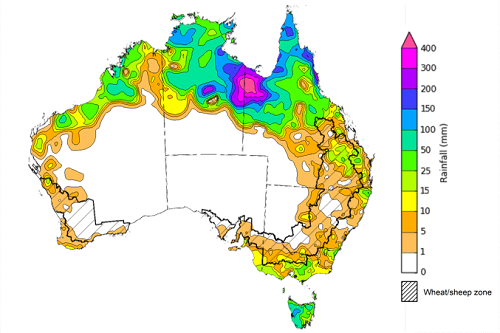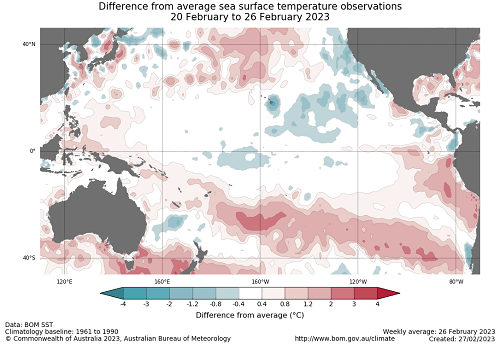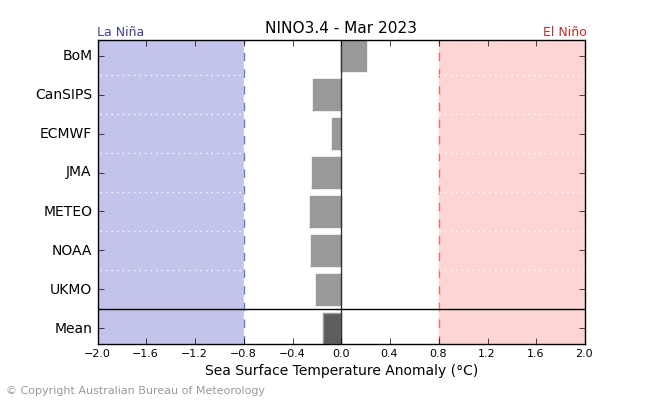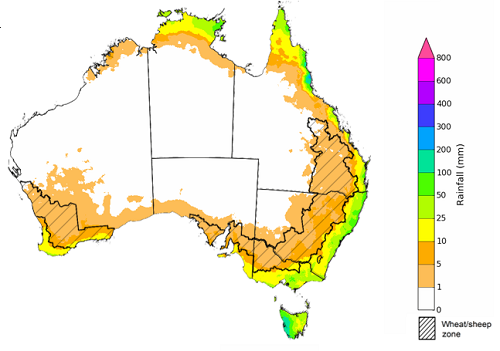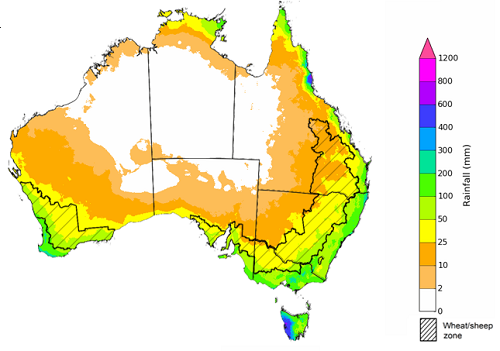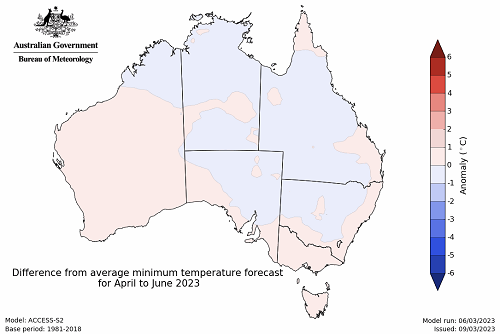Key issues
- For the week ending 8 March 2023, a monsoon burst has brought thunderstorms and heavy rain across the northern tropics throughout the week, with weekly totals greater than 150 millimetres recorded in parts of central Northern Territory and adjacent areas of north-west Queensland.
- Little to no rainfall was recorded in cropping regions over the past 7 days, except for parts of Queensland. Ongoing dry conditions across most summer cropping regions would have allowed for uninterrupted access to fields for crop maintenance activities and for the harvesting of early sown crops. However, in regions with below average soil moisture levels, little to no rainfall is likely to have negatively affected the growth and yield potential of late sown summer crops (see Section 1.1).
- La Niña is likely near its end. The oceanic indicators of La Niña have returned to neutral levels, while the atmospheric indicators that remain at La Niña levels are continuing to weaken. The Madden–Julian Oscillation (MJO) is currently weak; however, it is forecast to strengthen and re-emerge over the western Pacific during the coming fortnight. This may initially contribute to increased monsoonal activity across northern Australia, but as it progresses eastward it will increasingly favour drier conditions for tropical Australia (see Section 1.2).
- The outlook for April 2023 indicates that there is a 75% chance of rainfall totals between 10 and 50 millimetres for tropical northern Australia, eastern and south-eastern coastal areas, parts of Western Australia, as well as much of Tasmania. Rainfall totals in excess of 100 millimetres are expected in western Tasmania and in parts of north-eastern Queensland. For the remainder of Australia, rainfall totals are not expected to exceed 10 millimetres (see Section 1.3).
- The outlook for April to June 2023 suggests there is a 75% chance of rainfall totals between 25 and 100 millimetres across central and eastern New South Wales, northern and eastern Queensland, southern parts of South Australia and Western Australia, northern parts of the Northern Territory and much of Victoria and Tasmania. Rainfall totals in excess of 200 millimetres are forecast for coastal parts of New South Wales and Queensland, as well as western Tasmania.
- Over the 8-days to 16 March 2023, the monsoon trough is expected to generate rain and storms across the tropical north of Australia. Meanwhile, a low-pressure trough across eastern Australia is forecast to generate rainfall in excess of 25 mm, particularly over much of Queensland and in the northeast and coastal New South Wales. A high-pressure system is expected to bring mainly dry conditions elsewhere (see Section 1.4).
- Water storage levels in the Murray-Darling Basin (MDB) decreased between 27 February 2023 and 6 March 2023 by 271 gigalitres (GL). Current volume of water held in storage is 22 580 GL which represents 89 per cent of total capacity. This is 1 percent or 174 GL more than at the same time last year.
Allocation prices in the Victorian Murray below the Barmah Choke remained steady at $15 per ML from 2 March 2023 to 9 March 2023. Prices are lower in the Murrumbidgee and in regions above the Barmah choke due to the binding of the Murrumbidgee export limit and Barmah choke trade constraint.
Climate
For the week ending 8 March 2023, the northern monsoon has brought thunderstorms and heavy rainfall to much of Australia’s tropical north throughout the week. Weekly totals between 25 and 150 millimetres were recorded in the north of the Northern Territory, northern Queensland, and parts of northern Western Australia. Weekly totals greater than 150 millimetres recorded in parts of central Northern Territory and adjacent areas of north-west Queensland. Frontal activity in southern Australia brought rainfall totals of between 10 and 50 millimetres to Tasmania and southern Victoria, as well as pockets of eastern Queensland and New South Wales over the past week.
Little to no rainfall was recorded across the cropping regions over the past 7 days, except for parts of central Queensland. Ongoing dry conditions across most summer cropping regions would have allowed for uninterrupted access to fields for crop maintenance activities and for the harvesting of early sown crops. However, in regions with below average soil moisture levels, little to no rainfall is likely to have negatively affected the growth and yield potential of late sown summer crops.
Rainfall for the week ending 8 March 2023
Note: The rainfall analyses and associated maps utilise data contained in the Bureau of Meteorology climate database, the Australian Data Archive for Meteorology (ADAM). The analyses are initially produced automatically from real-time data with limited quality control. They are intended to provide a general overview of rainfall across Australia as quickly as possible after the observations are received. For further information go to http://www.bom.gov.au/climate/rainfall/
Throughout autumn the climate drivers with the largest potential impact on Australia’s climate patterns are the El Niño–Southern Oscillation (ENSO) and the Madden-Julian Oscillation (MJO). These climate drivers are likely to influence the growth and development of later planted summer crops in northern growing regions, pasture growth across both northern and southern Australia and planting opportunities for winter crops.
La Niña has weakened in the tropical Pacific Ocean and is likely near its end. Oceanic indicators of La Niña have returned to neutral levels, while atmospheric indicators of La Niña continue to weaken. The Southern Annular Mode (SAM) is currently positive but is expected to return to neutral during the coming week where it is anticipated to remain neutral for the coming month. Neutral SAM has little influence on the rainfall and temperature outlook for Australia.
Difference from average sea surface temperature observations 20 February 2023 to 26 February 2023
International climate model outlooks for the NINO 3.4 region in March 2023
Issued: 28/02/2023
All, but one, international climate model surveyed by the Australian Bureau of Meteorology suggest sea-surface temperatures in the tropical Pacific will remain neutral through the southern hemisphere autumn, with one model reaching El Niño thresholds in May. For the period ending 6 March 2023, the 30-day Southern Oscillation Index (SOI) value was +9.0, which has decreased slightly over the past weeks; another indicator of the weakening La Niña.
It is important to note that while most models suggest there is an increased chance of El Niño developing in mid-to-late 2023, the model accuracy when forecasting through autumn is low, and therefore ENSO outlooks that extend past autumn should be viewed with caution.
30-day Southern Oscillation Index (SOI) values ending 6 March 2023
The Madden–Julian Oscillation (MJO) is currently weak, however, it is forecast to strengthen and re-emerge over the western Pacific during the coming fortnight. This may initially contribute to increased monsoonal activity across northern Australia, but as it progresses eastward it will increasingly favour drier conditions for tropical Australia. While over the Pacific Ocean, the westerly winds associated with the MJO are expected to bring about the weakening of the trade winds, which may further contribute to the breakdown of La Niña in the coming fortnight.
Madden–Julian Oscillation (MJO) daily index
These climate outlooks are generated by ACCESS–S (Australian Community Climate Earth-System Simulator–Seasonal). ACCESS–S is the Bureau of Meteorology's dynamic (physics-based) weather and climate model used for monthly, seasonal, and longer-lead climate outlooks. For further information, go to http://www.bom.gov.au/climate/ahead/about/.
The Bureau of Meteorology’s latest rainfall outlook for April 2023 indicates drier than average conditions are expected across much of Australia.
The ACCESS-S climate model suggests that there is a 75% chance of rainfall totals between 10 and 50 millimetres for tropical northern Australia, eastern and south-eastern coastal areas, parts of Western Australia, as well as much of Tasmania. Rainfall totals in excess of 100 millimetres are expected in western Tasmania and in parts of north-eastern Queensland. For the remainder of Australia, rainfall totals are not expected to exceed 10 millimetres.
Across much of the cropping regions there is a 75% chance of rainfall totals less than 10 mm, except for in eastern Victoria, and in south-eastern New South Wales and Western Australia where it may total up to 25 mm.
Rainfall totals that have a 75% chance of occurring in April 2023
Issued:09/03/2023
The rainfall outlook for April to June 2023 suggests that below median rainfall is likely to very likely (60% to greater than 80% chance) for most of Australia the next three months. However, for tropical northern Queensland, parts of coastal New South Wales and southern Tasmania there is have close to equal chances of above or below median rainfall.
Chance of exceeding the median rainfall April to June 2023
Issued: 09/03/2023
The outlook for April to June 2023 suggests there is a 75% chance of rainfall totals between 25 and 100 millimetres across central and eastern New South Wales, northern and eastern Queensland, southern parts of South Australia and Western Australia, northern parts of the Northern Territory and much of Victoria and Tasmania. Rainfall totals in excess of 200 millimetres are forecast for isolated coastal areas of New South Wales and Queensland, as well as western Tasmania.
Across cropping regions, there is a 75% chance of receiving between 25 and 100 millimetres across much of New South Wales, parts of eastern Queensland, Victoria, South Australia and Western Australia.
These rainfall totals are well below average for this three-month period across most of Australia. Relatively dry conditions during February and early March have seen soil moisture levels decline across large areas of Australia. This lack of rainfall and decline in soil moisture levels has led to reductions in yield potentials for later sown summer crops. Given these recent declines in soil moisture levels and the increased likelihood of below average rainfall over the next three months, crop producers will require adequate and timely rainfall to maintain current summer crop yield potentials to support the sowing and establishment of winter crops. For livestock producers experiencing below average rainfall, particularly across southern Australia, this will likely result in below average pasture production. However, ample supplies of conserved fodder will likely enable most producers to maintain current production levels and stocking rates.
Rainfall totals that have a 75% chance of occurring April to June 2023
Issued: 09/03/2023
The temperature outlook for April to June 2023 indicates that maximum temperatures across most of Australia are likely to be close to the 1990-2012 average (the difference between -1°C to +1°C) while slightly warmer (up to +2°C) across much of Western Australia and South Australia and in isolated parts of Northern Territory, Queensland and New South Wales. The minimum temperatures across most of Australia are expected to be close to the 1990-2012 average (the difference in the range of -1°C to +1°C).
Predicted maximum temperature anomaly for April to June 2023
Predicted minimum temperature anomaly for April to June 2023
Over the 8-days to 16 March 2023, the monsoon trough is expected to generate rain and storm across the tropical north of Australia. Meanwhile, a low-pressure trough across eastern Australia is forecast to generate rainfall in excess of 25 mm, particularly over much of Queensland and in the northeast and coastal New South Wales. A high-pressure system is expected to bring mainly dry conditions elsewhere.
Across Australian cropping regions, rainfall totals up to 100 millimetres are expected for much of Queensland, and up to 50 millimetres in much of the northeast of New South Wales over the next 8 days. Little to no rainfall in expected in the remaining cropping regions. If realised these falls are likely limit field access for crop maintenance activities and delay the harvest of early sown crops across summer cropping regions in Queensland and the far northeast of New South Wales. These falls are likely to provide a timely boost to soil moisture levels and stabilises yield potentials for late sown summer crops following recent reductions due to predominantly dry conditions during February and early March. The forecast rainfall over much of central and northern Queensland is likely to further benefit pasture growth rates and availability.
Total forecast rainfall for the period 9 March to 16 March 2023
Note: This rainfall forecast is produced from computer models. As the model outputs are not altered by weather forecasters, it is important to check local forecasts and warnings issued by the Bureau of Meteorology.
Water
Water storages, water markets and water allocations - current week
The Tableau dashboard may not meet accessibility requirements. For information about the contents of these dashboards contact ABARES.
Commodities
Information on weekly price changes in agricultural commodities is now available at the Weekly commodity price update.

